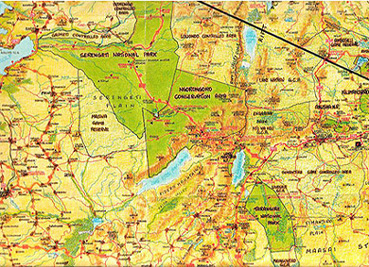
From Mombasa to Serengeti's Plains (Part 1/2)
INTRODUCTION
By end of August 2000 we booked a 4-week holiday as from January 16 until February 14, 2001 as the present to ourselves for our advanced "Golden honeymoon" that included a 7-day Tanzania Safari. When "the house warming" couple arrived on January 13 we were ready for the departure despite pains in my left hip for that the surgery was fixed for March 21st. We were looking forward despite some minor ailments acquired before starting our trip knowing that these could "explode" when "imported" in a tropical climate. However this Tanzania Safari should remind us on the last leg of our month's long safari driving in a 1964' Volkswagen during our local leave in July/August of 1965. From Munich we flew 8-hour non-stop during night hours to Mombasa arriving there early morning.
The first 9 days of acclimatizing we spent mostly sun basking in a long chair under a round palm leaves canopy next to the beach of our Leisure Lodge Hotel where we have swam in tepid seas several times depending upon the tidal movements. On January 21 a bus picked some twenty tourists from various hotels at the South Coast of Mombasa bringing us to Moi International Airport of Mombasa. The 50 km drive takes about 2 hours due to densely populated stretches along the main road and a time-consuming crossing on a ferryboat of Mombasa Creek. That Creek is the access large Kilindini Harbor of Mombasa that is situated on an island.
 |
A cutout from a new map of Northern Tanzania showing Kilimanjaro at top right corner and Lake Victoria at top far left corner. At center right is Ngorongoro Conservation Area and left to it Serengeti National Park. Below right is Tarangira National Park and above it is Lake Manyara slightly to left. The Ngorongoro Crater is almost at the center of this cutout. |
BEGIN OF TANZANIA SAFARI - From Mombasa to Arusha
After 2 hour of waiting we took of in a twin turboprop to fly to Tanzania's Kilimanjaro International Airport. Here everybody had to get out to check passports for visas and health certificates, as this airport is the official entry into Republic of Tanzania. Half an hour later we embarked the same aircraft arriving at Arusha local airport close to 15h. The coordinator of SIMBA SAFARI TOURS met us there and handed out papers about the safari tour. Our luggage was packed into the assigned mini van that was for 6 or 7 passengers. Picnic lunch boxes were distributed then by MATTHEW our "driver & guide" in one person who was a mountain of a man from the Chaga tribe living on slopes of Kilimanjaro. We left the airport near 16h stopping for a quick "lunch" and continued the drive relatively fast on a tarmac stretch of some 50 km here. Later we turned onto an earthen road to arrive at the gate of TARANGIRA NATIONAL PARK soon after 17h.
The day was overcast so the light reduced too fast. The intensive rains made the countryside lush green everywhere. In muddy pools birds and animals would find easy to drink despite dangerously high grass that could make them an easy prey to the not visible lurking predators. We saw a leopard in a tree hole some 30m away waiting for darkness to fall where as birds were settling on branches high enough above tall grass. We came upon a large troupe of Impala gazelles grazing next to about fifty baboons - all nibbling on some grass seeds with a great gusto. There were more scenes that delighted the four other fellow passengers for whom it was the first contact with the African bush. We arrived at TARANGIRA SOPA LODGE in full darkness at 19h, got to rooms fast and went for dinner soon after. Everybody was tired due to the climatic and altitude change of some +1.000m as well after traveling 160 km on "African" roads. The hotel went "dead" after 22h so surely nobody noticed a few drizzles sustaining during the night.
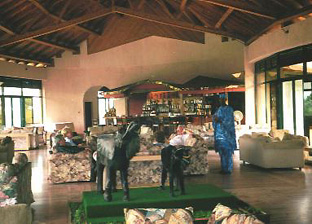 |
|
TARANGIRA NATIONAL PARK - Northern Tanzania
We got up for early breakfast and left the hotel at 8h
to zigzag through Tarangira NP for some 3.5 hours to return for lunch to
lodge at 12h. Matthew crossed Tarangira River several times over narrow
bridges or driving across concrete troughs at shallow water level. Generally
earthen roads lead through pristine grassy plains interspersed by Acacia
or Baobab trees at woodlands on lower hills. Tanzania's Tarangira NP covers
an area of 2.600km² that include swampy areas but is too small for
large wandering herds like Savanna zebras, wildebeest, Kaffer buffaloes,
Eland antelopes and elephants. Thus nearly 75% of these animals leave Tarangira
wandering of to larger plains like in Serengeti National Park (14.765km²).
We've seen quite a lot of elephants and antelopes incl. the smallest one
Dick Dicks, a variety of birds and monkeys on palm trees looking for fruits
there.
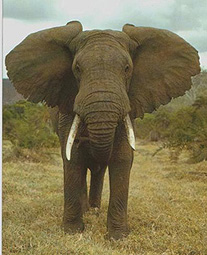
An aggressive elephant bull contemplates to charge at the intruders of his domain of the Tarangira National Park at Northern Tanzania. We decided to leave him at peace leaving the park fast. |
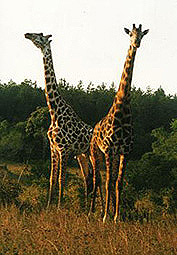
Two giraffe bulls stopped in their neck to neck playful combat watching the approach of a vehicle. The sunset has set in producing long shadows and coloring of grass and dense bush. |
After a torturing hour drive we came upon a slightly better road where a grader was trying hard to level grooves and routes. After a 70 km ride we came to the place Mto Wa Mbu (former Lake Manyara) that is a busy township with many shops along the road and several market places at back streets. Nearby to it is the "Mosquito village" famous for its enormous swarms of pest insects causing malaria sickness. Pelicans settle here on few tall Sausage trees just above the busy road that is quite unusual for this kind of water bird. Matthew stopped at a maize shop cum mill to order a bag of "posho" (white maize meal) when the very same moment young and old hawkers surrounded our vehicle. They were offering food and fruits, painted tablecloths and shirts but children were asking for ball-points or pencils, sweets or anything what tourist likely would give.
We left Mto Wa Mbu on an ascending earthen road that winds
between hills nicely cultivated on very rich soil. Matthew suggested stopping
at local fabric shop nearby the road where he'd get a shirt if passengers
would just enter and view around for a while. We've done as he proposed
so Matthew got his shirt and our ladies bought some cloths too. After a
Keratu settlement the road becomes steeper as it nears to Ngorongoro crater's
eastern slopes. We passed through thick forests to arrive to the East gate
of NGORONGORO CONSERVATION AREA at 18h. Through it a well kept earthen
road winds up and twist on until one comes to the crater's rim to a T-junction.
We turned right following the crater peripheral road for some 22 km to
arrive to NGORONGORO SOPA LODGE around 19h.
NGORONGORO CONSERVATION AREA - Visit to the Crater's floor
The name NGORONGORO means in Masai language "The Great Big Rock" which a Masai chieftain choosed for him when he saw that huge crater jutting out from Serengeti plains. In Masai language the word Serengeti means "limitless plains". The crater area at its rim measures 384km² and the height varies at 2280-2440m ASL where as the floor is at 1700-1830m ASL. The flora consists of Tropical Mountain Rain Forests and flattop Acacia trees, further there are grasslands, swamps and soda seas. Within the crater live some 53 kind of mammals and about 248 species of birds. There are several good lodges like the Sopa (at NE), Rhino, Crater, Wildlife Lodge next to the later two and the most posh one the Serena Lodge at SW.
A large group of Kaffer buffalos resting at Ngorongoro Crater's floor
In Sopa Lodge one has a perfect view down into the crater from all rooms. It's the place to observe sunsets providing that clouds don't obstruct it. Sopa Lodge fits nicely into the surrounding with its two large round buildings roofed conical (the restaurant and the other one containing bars and recreation rooms). There of are two wings of smaller two storied round huts each contain 4 compartments with a large room cum anteroom and bathroom. Each compartment has an alcove with a wide window providing a perfect view into the crater.
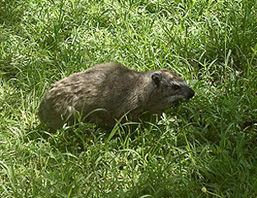
A rock hyrax looking for a good grazing place |
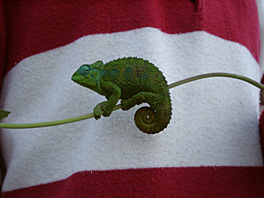
A young chameleonnot used to change colors yet |
Park's special 4 wheel cars were waiting on Sunday early
morning to take visitors to the Crater floor. Severino, also a Chaga tribe's
man, was our "driver cum guide" who lead for 4 of us to his vehicle that
had a 4W-drive. There exist two descending routes to the Crater floor and
we descended on the northern route that isn't so steep like the southern
one. Half way down close to the Old German Farm we saw larger herds of
zebras and wildebeests grazing. Not far away rested a lion of drenched
fur looking rather miserable and waiting for sun to appear through thick
fog. Severino led us to Lake Magadi first where large flocks of water birds
and European storks were wadding the shallows. One couldn't approach the
lake shore, as it was muddy due to lake's area that increased considerably
after lot of recent rains. A huge herd of buffaloes rested close by and
a few bulls looked rather ominously. Along a grassy plain we came upon
three rhinos but had to keep the prescribed safety distance of some 30m.
There are 13 rhinos within the crater being are under constant ranger's
vigilance, as poachers would kill any rhino leaving this safety heaven.
One had to contemplate their dreadful destiny as black rhinos were almost
exterminated in East Africa by poaching.
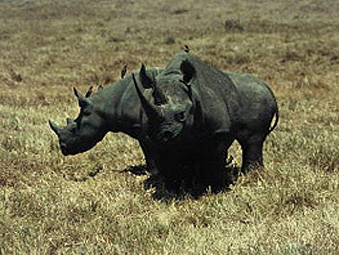
Mother rhinoceros protects her almost grown up calf. (Picture taken during the safari in 1965' dry season) |
Behind Engitati Hill (1793m ASL) there are three routes
leading from crater's rim down to the floor. The uppermost is the steepest
one and animals migrate on it, the middle one take Masai herdsmen driving
their herds and the lowest one use Park's vehicles. All of them descend
from Windy Gap that is a wide cut into the western crater's wall. I could
report on and on about elephants cooling and showering with muddy water,
a warthog sow with 4 piglets, hippos in Mandusi Swamp fed by Munge River
etc. Further on route we met several groups of male elephants some munching
lush high grasses or on low hanging tree branches. It's an interesting
fact that male elephants only come down to crater floor's whereas the cows
with their young stay at the crater's outer slopes overgrown with thick
bush and forest. The most memorable episode was a group of 4 lionesses
with totos ("toto" means small in Swahili) and a lion that all slept next
a water edge. Their stomachs were so "swollen" of food and too heavy on
them so they had just managed to the water edge. Hardly any of the animals
stirred at all during some 15 minutes of watching them as they mirror pictured
on the water surface when the sun came out.
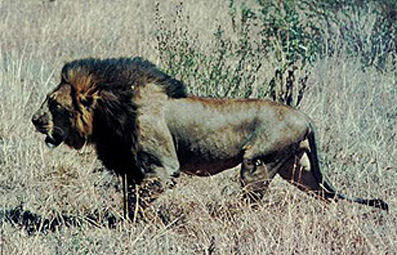
Serengeti's dominant lion with typical black mane (Picture taken during our safari in 1965) |
Later we had a picnic luncheon out luncheon boxes distributed
at a resting place with simple lavatory facility near by. At 15h we had
to hurry out of the crater as a storm was approaching that could make ascending
too hazardous. Safely back to lodge we just missed the last heavy drops.
The sun came out by 17h but there wasn't to be a sunset as thick clouds
still hang on crater's western rim. The dinner was served in Sopa Ngorongoro
Lodge's circular restaurant where at center of which the cozy warmness
spread from a large hearth. After the sunset it became rather chilly outside
so one had to put on a sweater and wind breaker at least. After the dinner
we returned to our rooms and the packing was the first thing to do. We
had a warm bath and slept like hogs in wide single beds until the alarm
watch woke us up rudely at 06:30h. It was Monday, January 29 that would
turn into a "blue Monday" later and fateful for the 3 vehicles of SIMBA
TOURS.
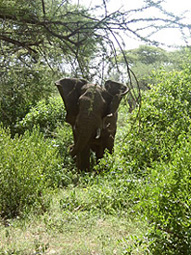 |
|
One should know that the Ngorongoro Crater was Masai's pastureland before 1891 when the first European Oscar Baumann arrived there in. When Germans lost their East African Colony in 1918 German colonists had also to leave their ranches like brothers Siedentopfs who had one in the Crater. The title of a WILD CONSERVATION REGION was affirmed to Serengeti and Ngorongoro Crater by 1937 only. The status of a NATIONAL PARK was acknowledged to all regions in Serengeti and Ngorongoro in 1956. As from 1975 it is forbidden to Masais living within the Crater. The Park's management issues short-term permissions to Masais herdsmen for grazing and watering their herds there only.
With Matthew at the wheels again we returned to the road
junction some 21,7 km southwards and not far from it stands the GRZIMEKS'
monument next to the Crater's southern rim road. Here Michael Grzimek ("Serengeti
should not die") was buried after his tragic plane crash in 1959 and his
father's urn was placed into the grave when Prof. Bernhard Grzimek died
in 1987. After a short stop we continued westward bound descending to the
Ngorongoro Conservation Area's plains at a road junction leading to Serena
Lodge and its landing strip there. Matthew's next "duty stop" was at BOMA
OLOIROBA, a Masai village, which tourists can visit and take pictures therein.
One of our fellow travelers was prepared to pay TSh 6.000 (some $10) but
the stern looking "cashier" said either all six of us pay each or none
can enter the boma. So we said "NO!" and continued onwards to the next
stop at OLDUVAI GORGE.
|
Matthew's group standing next to the tombstone of Prof. Bernhard Grzimek and his son Michael. View down into the Olduvai River deep valley (right) |
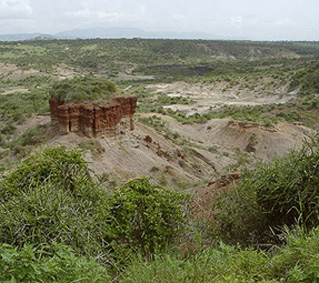 |
Masai call the wild sisal plant "Olduvai". Here through
a deep gorge flows a river of the same name. I don't remember having seen
water flowing here during our safari in August of 1965 as it was the dry
season then. At those days we walked down to the depth of gorge and visited
excavation sites - however very few tourists were then. Now we stopped
for a lookout from top at the gorge's rim and visited an interesting museum
there. The gorge itself is unique in itself as it gives a perfect view
very far backward into the history of human kind and animals world. Early
in 1913 first signs were discovered of a "Homo sapiens" followed by Mary
Leaky uncovering "Australopithecus robustus or boisei" in 1959. In 1960
Jonathan Leakey discovered remnants of "Homo habilis" some 1,6 Mio year
old and a 1,2 Mio year old skeleton of "Homo erectus" in 1963. Again Mary
L. found footprints in mud that were dated back to some 3,6 Mio years of
age. All these findings and many fossils of long gone animals are on display
in a perfectly organized small museum. One could look at the complete casting
of "Lateoli footprints" that belong to a human ancestor "Australopithecus
afarensis". Having enough of the lecture we were eager to drive on to the
lush green plains waiting for us.
ON WAY TO SERENGETI NATIONAL PARK - Straight into mire trap!
As we descended the road of stabilized cinder there were lush green looking meadows but no animals grazing at. Matthew explained that wildebeest's cows visit this area when calving as the grass is exceptionally reach on minerals here - but they have left it already. We turned of following a graveled road leading towards SERENGETI NATIONAL PARK entrance gate. Soon one had to drive slowly through a concrete trough built into the OLDUVAI STREAM riverbed. Here one could see Masai women washing their linen and few younger men smeared on themselves red ocher soil after bathing in the stream. Some hundreds meter onwards young Masai herdsmen lead large flock of goats and donkeys following a brook with low green bushes. Few dogs run in front of the herd chasing away grazing wild animals in front of it. Sometime later Matthew turned of the gravel road overtaking the Masai's flock driving not too fast across the grassy plain. Not long after we came upon large herds of zebras, wildebeests (or white bearded gnus), a shy herd of large Eland antelopes, interspersed with large groups of Impalas, Thomson's and Grant's gazelles.
There were probably thousands of zebras and gnus some of the later with foals grazing at plain's lush meadows spreading at both sides of the borderline between Ngorongoro CA. and of Serengeti NP. Large flocks of Burschell's zebras, wildebeest, various gazelles and larger Eland and Topi antelopes congregate here when the heavy rains in March start to trigger their migration. They would move towards the western corridor into central parts of Serengeti by April and May. Later by August the herds would move onwards passing through the IKORONGO controlled area at North of Serengeti and cross over into the Masai Mara Game Reserve by September. Then herds would return to Serengeti plains as soon they feel that new rains have started at the South sometime in November. Thus the herds would conclude the annual their migration cycle once again.
Matthew steered the vehicle over unending grassy slightly undulated plains following the immense herds of zebras and gnus, a group of Eland antelopes rushed by and various smaller gazelles scattered when one came too close to them. Nobody noticed clouds that were pulling on shadow shadowing of the scorching sun as all were much occupied watching the boundless number of animals every where. Around midday a radio call came in from another SIMBA driver reporting that he saw a cheetah's female with her four almost grown up youngsters. Of course, Matthew changed the curse instantly and soon we saw few SIMBA vehicles that were converging towards at a not too distant meeting point. Everybody in the car got so busy with taking pictures with cameras or camcorder, as soon we were close enough to the cheetahs. A rather strong rain abruptly stopped our photographic excitement: the car roof pulled down and windows shut tightly.
Then mother cheetah got up and walked slowly away most probably looking for a dry shelter and her four cubs followed her reluctantly as annoyed by this entire nuisance. One or other of the cubs stopped for a moment looking back probably wondering why they had to move from this nice hump. Vehicles followed them for a while until they were out of cameras' reach and the intense rain made taking pictures impossible anyway. It was wise to stay put and to wait for the rain to stop anyhow. Lunch boxes were distributed and one selected to eat some of included snacks only. We had a large box of fresh water bottles that should have be enough for the whole safari. After my wife collected snacks nobody wanted and sorted them in a few lunch boxes whereas the other ones would be disposed. Matthew would later distribute the set aside snacks to children waiting along route. This time our "snacks collection" should have different beneficiaries in a rather unpleasant anguish soon!
The rain stopped after say 20 minutes but I have had bad
foreboding thought. Prairie grass grows in Serengeti on a thin humus layer
on top of the "black cotton soil" - a clayey soil containing very fine
clay minerals. The cotton soil is capable to absorb a lot of humidity quickly
causing a significant increase of its volume and making soft and extremely
slippery. The driving on wet cotton soil could easily be compared with
conditions encountered when driving through thick layered fresh snow but
without thick profiled winter tires or with no mounted on chains. African
drivers like to give full gas forcing the engine to its maximum where as
driving in a wet clayey soil requires caution and some experience running
the engine at a higher gear with little gas as possible. Seldom an African
driver would change the gear thus not caring for the right speed that would
correspond to the actual road conditions.
| Matthew's vehicle is stuck with all four wheels deep in soft soil of the Serengeti National Park plain after a 20 minutes rain only. The cheetah mother and her four cubs moved away but few spotted hyenas closed in looking for some food remnants left by cheetahs. |
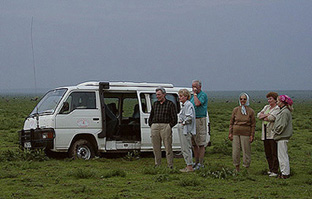 |
After a while of waiting Matthew decided that's circumstances are good enough to get onto the gravel road some 800m away only. Of course he started with maximum of power pursuing a straight direction to its goal and the disaster struck consequently soon after. Our SIMBA vehicle had the rear wheel drive only so its wheels dug deep furrows into grassy surface until it was stopped by a mud wall its bottom sitting firmly on top it. We were stuck firmly in Serengeti's cotton soil at about 2 PM on that "BLUE" Monday JAN 29, 2001. The graveled road looked unreachable for our van at that moment. We found out soon after that several cars scattered nearby shared the same of our destiny. One hoped that the help would come soon that wouldn't be the case!
Matthew started talking Swahili into his radio emitter and my wife Ljiljana could understand some of his excited talking. We were in a big trouble so the best was to get out of the van first so that one would be able to inspect the situation. We certainly couldn't get out of these deep furrowed tracks without help from car equipped with a winch and steel wire of 50m at least. To my dismay I discovered that our vehicle had a short shovel, a reserve tire, one winch to be used on a hard stand only and a 4m long chain good for pulling another car on hard surfaced road. The time was passing fast and the sky was still overcast so our chances were diminishing with every hour standing hopelessly around. A 4 wheel driven SIMBA car returned to pull us out so when the chain was fixed in between both drivers started their engines at full power just to move so far as a few meters. Both vehicles were dug deep enough into cotton soil that stopped them definitely. Such a procedure was just good for nothing. The African drivers' pride wouldn't allow listening to of a passenger's advice though! I just couldn't stand there watching drivers' lack of comradeship and lack of some leadership and had to walk away. Thinking about later I couldn't grasp the indecision to walk some 800m during the daylight and to wait for help at the main road?
Radio was cracking again as a few drivers joined in and
after a lengthy ensuing palaver they dispersed leaving passengers alone
without any explanation. Two of us could understand fragments what they
talked about so it was obvious that no help would be coming for a while
or so. Several hopeless trials followed during later hours that even aggravated
the situation of all stranded tourists in several dispersed cars around.
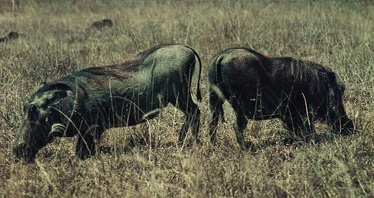
A pair of warthogs grazing in open plain wary of any approaching danger during 1965' dry season. |
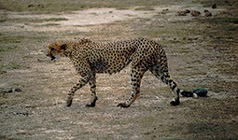
A male cheetah walking Serengeti's grass less plain during the dry season when we visited this place in 1965. |
I tried to send distress calls through on of the two channels installed on Matthew's radio but failed in all trials. SIMBA radio has two channels only linked to their dispatcher sitting in Arusha so the connection was rather poor due to geographical configuration and distance! Yet there are several operating radio stations close by like at Ngorongoro Crater police HQ, Game wardens stations and one in TAWISA's camp only 3 km far away. After the sunset around 6 PM it was getting darker fast also due to overcast sky.
After some time we walked over to another SIMBA car some
100m away taking small luggage with us that was to be of minimum weight
on such a trip. Once everything was stowed away we boarded the vehicle
- there was no point to argue about not doing it. The good driver started
the engine and the car moved under full power a few meters only before
it was firmly dug in mud. The driver started furiously digging out wheels
- an unattainable undertaking! After this mishap we returned to Matthew's
car after 19 hours in full darkness. I fell full length in a furrow and
instantly felt a throbbing pain in my left leg ailing hip joint. Back to
Matthew's van every aperture was closed tight as zillions of "dudus" (Swahili
for any kind of insect) would converge upon the dimmest light right away.
It was getting cool so we pulled on windbreakers or pullovers when somebody
mentioned that it'd be time for a dinner.
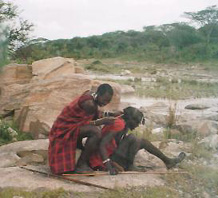
Two Masai men at hairdressing task on the bank of Olduvai River |
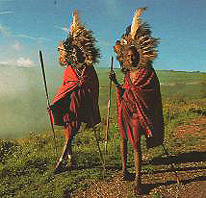
Two Masai morans (warriors) with decorative hair styling (Photo by C. Ratier 1999) |
My good wife got hold of lunch boxes filled with left over snacks or goodies from lunch. Using my two pin lights, that I always carry close to reach, Ljiljana started a kind of auction offering one item after the other she got hold from the box. The snacks or goodies nobody wanted some 5 hours before were distributed to the hungry and frustrated fellow passengers. Our spirits hadn't risen at all so we readied ourselves to spend a night in this vehicle. The seats were too hard for the weary bodies though and there wasn't enough room to stretch legs even if one would lie down. There wasn't enough space for three elderly couples with their different handicaps anyway! Hours passed so everyone tried to accommodate himself the best way as possible in that restricted space and were dozing of. In the overall quietness one could hear animals as they were moving close by, sometimes hyena's calls were close and then moved away. Thousand over thousand dudus were omnipresent and got busy on panes when somebody lit a light inside.
Some time later one could car lights moving forward probably to the one stranded car some 200m away. Then car lights returned the same way disappearing in the night. A problem cropped up how to deal with a lady's urgent needs where as gentlemen solved it by stepping out of darkened car moving along its whitish body to reach the furrow behind it. The ladies didn't like to get out into the wilderness at all. Suddenly we saw car lights closing in our direction so hopes rose that the rescue may be coming after all. It was close to 23 hours when a car approached stopping probably a few hundred meters far of. Its lights vanished for a moment and then we noticed two red lights that were turned of too. Then a wobbling light source was coming closer towards us at last so Matthew went out to meet the man when he was close enough.
Not long after that we were marching between two of them with storm lanterns marking the path us and carrying our luggage to a waiting car. I carried my cameras walked steadily watching every step in the glow of my pin light. After a while we came to a pickup, luggage was stowed the best way one could in full darkness and five fellow passengers climbed its tailboard. I was seated next to the driver not too comfortably but still better than the rest had it at the rear as told later. The pickup started slowly with its engine grinding in a strange sound so after short time steam clouds appeared probably from its cooler grid. Temperature gauge went into red and the driver had to stop the engine, went out and opened the engine cover. A mighty steam cloud formed in the cool air instantly. At first I thought that the cooler lost water but it wasn't to be so as pickup's engine belt was destroyed so the ventilator couldn't work. Another car showed out of darkness and a long chain fixed to tow the pickup - we were almost on the graveled road.
Back on the graveled road we passed through the Olduvai river when the pickup's driver short switched the engine on and off to better control of steering or to help the pulling car in front. After a too long 15 minutes the convoy left the main road following a winding earthen track to the camp TAWISA. The managers of the camp catering for visitors of Wildlife Society from Paris welcomed us. Ladies were led to the "chow" (a latrine open to the sky) as they bravely sustained their needs so far. A freshly prepared dinner was waiting already and sitting around a large table we ate eagerly. It was midnight when the luggage brought into well lit dining room for everybody to find his own one and to go with a staff member to the allocated sleeping place. The camp had 16 tents with 2 or 3 canvas beds and all 15 stranded passengers were lucky to get this night accommodation after almost 10 hours of misery and ordeal.
Light went of in our tent at 00:30 of Tuesday when two of us fully dressed were in bed straight forgetting any hygiene formalities. The canvas bed was cold enough but we found few more blankets on a third bed and wrapped us to feel warm as one could under the prevailing circumstances. I didn't sleep well despite painkillers as my mind was still going crazy what happened or could happen during that 9 hours being caught in the mud midst wild animals roaming Serengeti's plains. Imagine we were so close to the main road say 800m only and to the camp TAWISA some 3 km only.
*** End of Part 1/2 ***